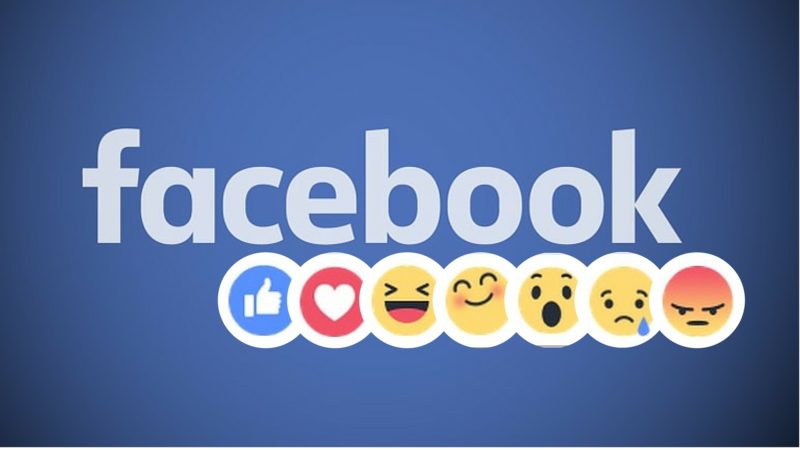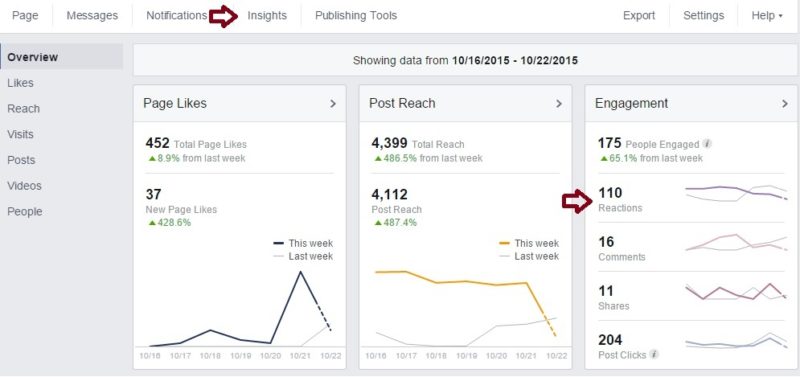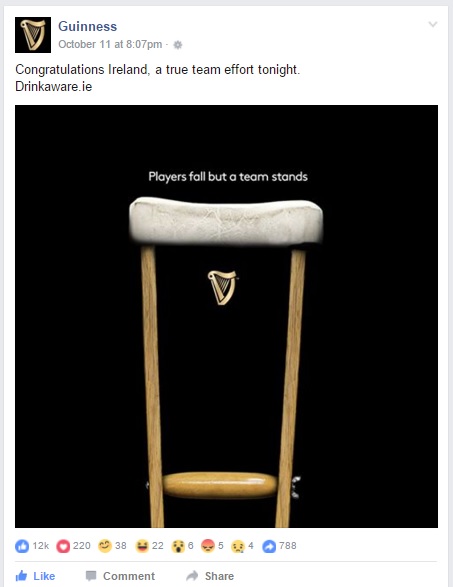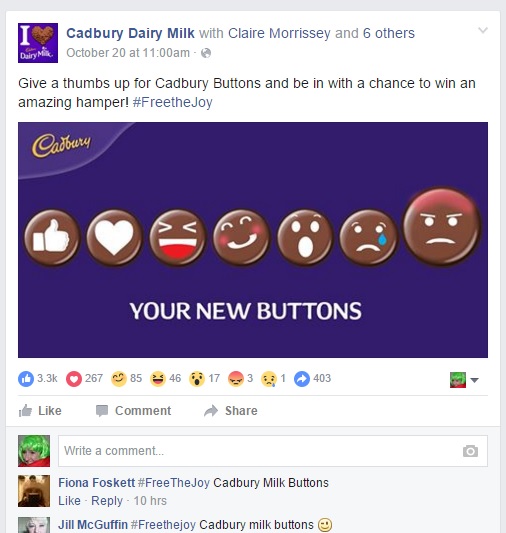Will Facebook’s New “Reactions” Get The Thumbs Up?
Facebook is testing a new feature in Spain and Ireland to expand the range of reactions to posts beyond just the "thumbs up." What might it mean for marketers once this feature is released worldwide? Contributor Jane Morgan explores.

To go beyond the thumbs-up — that’s what many Facebook users have sought for years.
Although one suspects that “dislike” would have done just fine for the news about Cecil the lion, Mark Zuckerberg doesn’t want a community of “dislikes” — rather, Facebook is about connections. Enter Reactions, which expands the range of reactions available beyond the simple “Like.”
Facebook has been testing Reactions in its desktop version in Spain and in Ireland, where I’m based, so I’ve had the opportunity to check them out and will share what I’ve learned so far.
The User Experience Of New Reactions
Hovering over the “Like” button, you are provided with seven different “reactions,” in emoticon format.

A discussion of what each emoticon means seems to defy intuitive usability, but Facebook made a brave design choice to skip the description (or indeed any intro) and just add in the emoticons. Perhaps a larger rollout will include some tips for users as Facebook learns from these betas.
Once you “react” to a post, your personal reaction shows immediately below the summary of all reactions. You can change your “reaction” by clicking the current choice, then choosing an alternative. And you can still hit the “Like” button for a quick thumbs-up, a nice touch for the time-starved user.

The author has no affiliation except as a consumer of Cadbury’s (Marvellous Creations)
Though Reactions are being tested on the desktop in the two markets, they have yet to appear in the app versions. Reactions are not available for comments — only the post itself.
Having worked with them for a few days now, I’ve found myself replacing the thumbs-up with a heart and using the cheery, closed-eye smile for things that made me feel warm and fuzzy inside.
Surprising items or posts evoking a “Hmm, that’s interesting” sentiment got the open-mouth emoticon. With users sharing family bereavements and other “endings,” the tears emoticon is sure to have a place (where a “Like” might have come off as insensitive). And Cecil and similar stories make for head-exploding stuff — enter anger.
Learning What Reactions Your Marketing Evokes
The changes have also been applied in these markets to Facebook analytics, called Facebook Page Insights, which is available to Facebook Page Admins via the “Insights” tab.
While updated from “Likes” to “Reactions,” as shown below (see the right-hand column), at the moment only the total number of reactions is shown — one reaction (of any type) equals one like. So the new reactions share this bucket together with other post-level insights (Likes, Comments, Shares, Link Clicks, Other Clicks and Photo Views).

Facebook Page Insights: Overview
We could soon have more details into the range of emotions our Facebook posts evoke within Page Insights. In the meantime, marketers can view the reactions at the individual post level, as shown on the Cadbury’s button example above.
Additionally, the new emoticons allow users to express their reactions to advertisements, an interesting development for Facebook Advertisers in the test markets. Currently, like on Page Insights, all reactions are counted together — the total “likes” in Ads Manager and Power Editor include all reactions.
How reactions may become part of the Facebook ads “relevancy score,” which impacts the advertising cost, remains to be seen. (For example I’d expect a “love” to be worth more than a “thumbs-up.”)
Marketing Inspiration To Connect
With these options likely to be more widely available soon, consideration of customers’ and prospects’ reactions should be baked into every marketer’s content plan and marketing strategy.
Facebook appears to be committed to expanding the range of reactions, so it’s worth reviewing why social media users share.
Geoffrey Moore’s Crossing The Chasm carefully considers the reactions and underlying motivation of prospects — a “must-read” for high-tech marketers. Research from The New York Times provides a useful marketing reference into the consumer behavior of sharing. They do it:
- To share valuable and entertaining content.
- To get the word out about important causes.
- To define ourselves to others (which is why I shared this).
- To grow and nourish our relationships.
More specifically, Marketo’s e-book delves into reasons for sharing on Facebook. Connection and reaction for marketers requires a solid understanding of brand values and a willingness to craft and curate stories around those values. According to the e-book, “[h]ighly shareable posts do at least one of the following:”
- Unite
- Give
- Advise
- Warn
- Amuse
- Inspire
- Amaze
Consider how your social media marketing content and publishing strategy addresses each of these seven reasons why prospects share.
Unite: Being Part Of Your Tribe
Content meant to unite people in a common cause or shared interest is often highly shareable. Facebook encouraged celebrating pride, for example, and a diverse range of organizations and individuals chose to show their colors. (Data-driven marketers will enjoy this analysis from the Facebook data science team.)
There are many examples of sport sponsorship (or brands simply aligning with sporting events) that fall into this category. This one from Guinness is all concept. The design is simple, yet elegant. Certainly something a social media marketer could rustle up.

(The author has no affiliation with Guinness except as a responsible consumer.)
Give: Offers, Discounts
Content that offers something to users or encourages them to give is also highly shareable. Charitable campaigns such as The ALS Ice Bucket Challenge have been well covered, but the ability to create offers on Facebook Pages has been way too quiet. Page owners with more than 50 fans can create offers for free. (Here’s how to create an offer, and here’s an example.)
Advise: Tips, Useful Information
You can tap into people’s desire to help one another by creating content that provides useful tips and advice.
Giving give people permission to talk about suicide and improving the ability to ask for help is at the heart of the non-profit Pieta House’s “Darkness into Light” message. On a lighter note, Oreo’s page (which favors quality over quantity) has great recipe examples — inspiring not just for food and confectionary marketers.
What questions do your prospects have about your industry or product(s)? How can you advise them?
Warn: About Dangers
Users often feel compelled to share warnings on Facebook or other social networks. Stereotypes and throwaway expressions are dangerous, as the Always “Like A Girl” campaign highlights. Facebook is all about imagery. You can’t create a Facebook ad without an image. The collaboration between LeanIn.org and Getty Images called “You can’t be what you can’t see” is timely for marketers.
Amuse: Entertaining Content
Who doesn’t love to entertain their friends? Cadbury confectioners, whose product range includes flat chocolate disks called buttons, shared this post — timely marketing designed to #FreetheJoy!

Inspire: Inspirational Quotes
With lots of great quotes on Facebook, you won’t have to look far for inspiration. But your interests and those of your prospects are likely different. To make sure you’re aligned with your target audience, set up a Facebook interest list of pages you expect your prospects to follow.
Demonstrating an exemplary understanding of entrepreneurship and decisions around marketing investment, this B2B example from Shopify is another example of a good idea simply executed.

GoldieBlox, a toy company whose mission is “empowering girls to be leaders in STEM with smart toys and awesome content,” often posts inspirational, share-worthy quotes.
Amaze: Amazing Pictures Or Facts
Of course, truly awe-inspiring content will almost always lead to shares. Consider, for example, this post from NASA showing a picture of Earth from space:
How does your marketing content plan and publishing plan consider customers’ emotional reactions? Good marketing tells stories to which prospects can relate. Perhaps it’s about longer-term sponsorship of an important cause, creating a substantial piece of content, or simply spontaneously rallying around a current event. Many of these examples highlight that the effort is in the idea, with execution the easier aspect.
Final Thoughts
No doubt this space will continue to evolve. Facebook is about “building and maintaining relationships,” and marketing (and, in particular, social media marketing) is about exactly that. If Facebook’s new Reactions feature gets the thumbs-up, how will you respond?
Contributing authors are invited to create content for MarTech and are chosen for their expertise and contribution to the search community. Our contributors work under the oversight of the editorial staff and contributions are checked for quality and relevance to our readers. MarTech is owned by Semrush. Contributor was not asked to make any direct or indirect mentions of Semrush. The opinions they express are their own.
Related stories